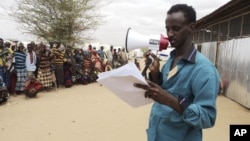Humanitarian conditions remain dire in the Horn of Africa, wracked by drought, famine and conflicts that have forced hundreds of thousands of people from their homes. Though hunger conditions have eased somewhat with the coming of the fall rains, more than 9 million people in the nations of Somalia, Ethiopia, Kenya and Djibouti remain in need of assistance.
The international response to the humanitarian emergency in Somalia has been significantly complicated and at times slowed by the actions of al-Shabaab insurgents and other armed groups. Throughout the emergency, though, the United States has been the largest humanitarian donor there and to the region writ large.
Due to the continuing need, the U.S. has recently announced an additional $58 million for relief efforts in the Horn, bringing the two year total contributed for helping the affected populations of the four nations to $1.3 billion. The international community has also continued to offer assistance, with the European Union recently providing an additional 30 million euros, or $39 million, in both short term relief and long-term aid.
The United States is also fighting chronic food insecurity by helping vulnerable communities diversify and adapt their livelihoods and improve smallholder agriculture so they can become more efficient. We will keep working with local governments and our partners to assist those most in need.
The international response to the humanitarian emergency in Somalia has been significantly complicated and at times slowed by the actions of al-Shabaab insurgents and other armed groups. Throughout the emergency, though, the United States has been the largest humanitarian donor there and to the region writ large.
Due to the continuing need, the U.S. has recently announced an additional $58 million for relief efforts in the Horn, bringing the two year total contributed for helping the affected populations of the four nations to $1.3 billion. The international community has also continued to offer assistance, with the European Union recently providing an additional 30 million euros, or $39 million, in both short term relief and long-term aid.
The United States is also fighting chronic food insecurity by helping vulnerable communities diversify and adapt their livelihoods and improve smallholder agriculture so they can become more efficient. We will keep working with local governments and our partners to assist those most in need.












